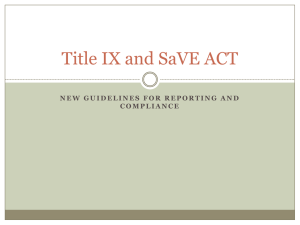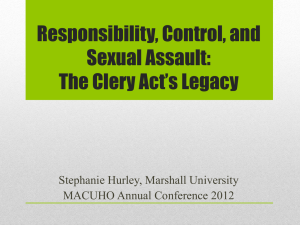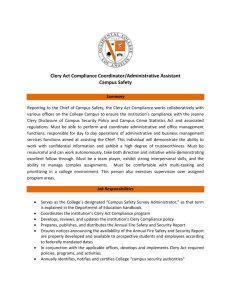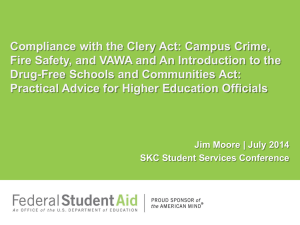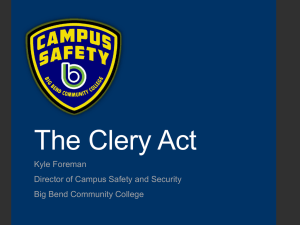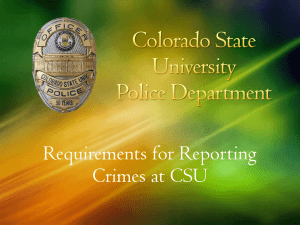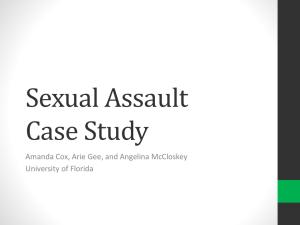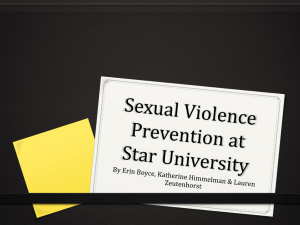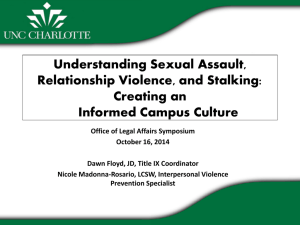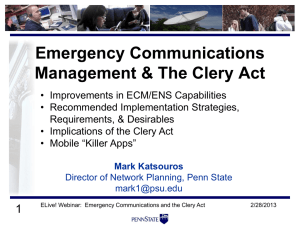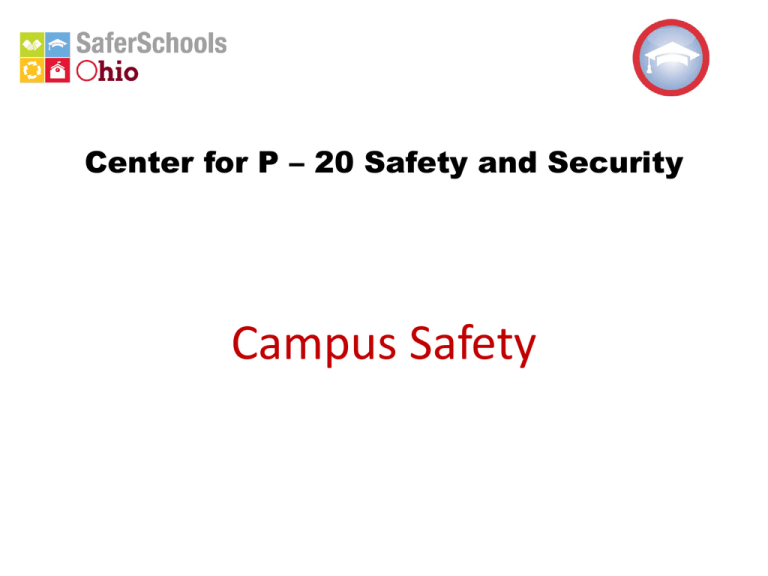
Center for P – 20 Safety and Security
Campus Safety
The Campus Safety Office
Campus Safety
The Clery Act
Title IX
Campus Safety Office
• History
• Campus Safety Office
• P – 20 Office
Campus Safety
• Police and Security
– All of our University System of Ohio campuses
have some type of dedicated security/safety
function:
• Security Operation
• Local Law Enforcement
• Campus Law Enforcement
Campus Safety
• How Safe are our Campuses?
• Perceptions of students and staff
Campus Safety
• How Safe are our Campuses?
• Perceptions of students and staff
• Local Crime Statistics
• Clery Report
• Other reports
Campus Safety
•
•
•
•
Campuses are generally very safe places
Crime is relatively flat, at least over the past 6 years
Urban campuses have unique challenges
Community Colleges have very few crimes
(reported)
• Campuses experience the same challenges as
general society with respect to sexual assault
reporting
The Clery Act
• The Jeanne Clery Disclosure of Campus Security
Policy and Campus Crime Statistics Act (or Clery Act)
• Compliance is monitored by the United States
Department of Education.
• The law is named for Jeanne Clery, a 19-year-old
Lehigh University freshman
• The Clery Act, signed in 1990, was originally known
as the Crime Awareness and Campus Security Act.
The Clery Act
• Amended in 1992, 1998, 2000 and 2008 by the
Higher Education Amendments.
• Amended in 2013 as part of the Violence Against
Women Reauthorization Act (VAWA).
The Clery Act
The Clery Act requires colleges and universities to:
• Publish an Annual Security Report (ASR).
• To have a public crime log. *
• Disclose crime statistics.
• Issue timely warnings about Clery Act crimes.
• Devise an emergency response, notification and
testing policy.
• Enact policies and procedures.
• Publish an annual fire safety report. *
The Clery Act
• The Clery Act requires institutions to disclose 3
general categories of crime statistics:
7 Clery Act Crimes;
Hate Crimes—incidents motivated by bias;
Arrests and Disciplinary Referrals:
Weapons Violations,
Drug Abuse Violations, and
Liquor Law Violations.
Clery Act
Looking Ahead – New Regulations
•
•
•
•
Maintain more statistics;
Clarify when an institution may “unfound” reports of crimes;
Revise the definition of “rape”;
Revise the categories of bias for the purposes of Clery Act
hate crime reporting;
• Specifically address how the institution addresses incidents of
Domestic Violence, Dating Violence, Sexual Assault and
Stalking
• Provide incoming students and new employees information
about primary prevention and awareness programs;
• Provide ongoing prevention and awareness campaigns for
students and employees;
Clery Act
Looking Ahead – New Regulations
• Require institutions to provide for a prompt, fair, and
impartial disciplinary proceeding;
• Describe each type of disciplinary proceeding used by the
institution;
• List all of the possible sanctions that may be imposed
following the results of any disciplinary proceeding;
• Describe the range of protective measures available following
an allegation of dating violence, domestic violence, sexual
assault, or stalking;
• Stalking that crosses calendar years must be recorded in each
year in which the stalking is reported.
Clery Act
Looking Ahead – New Regulations
• Provide information on how to file a disciplinary complaint;
• Notify victims how to request changes to academic, living,
transportation, and working situations and how to request
protective measures;
• Clarify how the definitions in the FBI’s UCR Program apply to
the new regulations;
• Revise exception to the Hierarchy Rule;
• Requires policy statements to address procedures for cases of
dating violence, domestic violence, sexual assault, and
stalking;
• Change the definition of “proceeding”.
Clery Act
Looking Ahead – Compliance
• Significant increase in the number of program
reviews:
2011 – 2X the reviews it performed in the
previous 2 years
Last 5 years – Nearly 2X the reviews of the first 20
years
• Compliance teams more robust = greater capacity
(and they’re GOOD)
• Reviews more comprehensive
Clery Act
Looking Ahead – Policy Statements
63
32
7
O
Clery Act
Looking Ahead – Policy Statements
63
The current number of policies required under Clery
32
The number of new policies required by VAWA
7
Of the 32, the number of policies that are revisions
Clery Act
Looking Ahead – Policy Statements
88
The NEW number of policies required by Clery
Clery Act
For the consumer, stats are not easily accessible
They reside in a cumbersome database that does not
provide easy-to-read comparisons or analysis
Many of the stats that matter most to students,
parents and campus community members aren’t
collected
Crime happens off-campus
Crime is often under- or unreported
Sexual violence underreporting is significant (<5%)
Other factors impact collection and disclosure
Title IX
Title IX of the Education Amendments of 1972 (Title
IX), 20 U.S.C. §§ 1681 et seq., prohibits
discrimination on the basis of sex in education
programs or activities operated by recipients of
Federal financial assistance.
Title IX
• Sexual violence is a form of sexual harassment
prohibited by Title IX.
- Sexual violence refers to physical sexual acts
perpetrated against a person’s will or where a
person is incapable of giving consent due to the
victim’s use of drugs or alcohol
- An individual also may be unable to give consent
due to an intellectual or other disability
- May include rape, sexual assault, sexual battery,
and sexual coercion, domestic violence, dating
violence, stalking
Title IX
“eliminate the harassment”
Title IX
“eliminate the harassment”
• Take immediate action to eliminate the
harassment
• Prevent its reoccurrence
• Address its effects
Title IX
• Respond
• Investigate
• Report
Title IX protects students from
sexual harassment in an institution’s
education programs and activities, including:
- All academic, educational, extracurricular, athletic, and other
programs of the institution
- On-campus, off-campus, in transit, sponsored at other locations,
etc.
Title IX
What Institutions Must Do
• Appoint Title IX Coordinators
• Training for administrators, teachers, staff, and
students (ensure they understand sexual harassment
and violence)
• Those involved in implementing Title IX grievance
procedures must have training or experience in
handling complaints
Title IX
What Institutions Must Do
• Institutions should implement preventive education
programs
• Make victim resources, including comprehensive
victim services available
• Institutions should develop specific sexual violence
materials that include policies and resources for
students, faculty, staff, and administrators
Title IX
What Institutions Must Do
• Title IX coordinators must have adequate training
• Make victim resources, including comprehensive
victim services available
• Law enforcement unit employees should receive
training
Title IX
What Institutions Must Do
• Anyone involved in processing, investigating, or
resolving complaints must have training and/or
experience:
- Institution’s obligations to address allegations;
- What constitutes sexual harassment, including sexual
violence;
- The institution’s grievance procedures;
- How to conduct Title IX investigations; and,
- Link between alcohol and drugs and sexual harassment
and violence
Title IX – Clery Intersections
Many of the Title IX requirements are now
codified under Clery
Title IX – Clery Intersections
Many of the Title IX requirements are now
codified under Clery
• Training
• Reporting
• Awareness
• Title IX Coordinator
Title IX – Clery Intersections
What’s Next?
Institutional Responsibilities
More Regulations
Guidance X 2
Title IX – Clery Intersections
What’s Next?
To Comply: Align Resources, Leadership &
Objectives
My Contact Information:
Rick Amweg
Executive Director
Center for P – 20 Safety and Security
614-644-2641
ramweg@regents.state.oh.us
saferschools.ohio.gov

